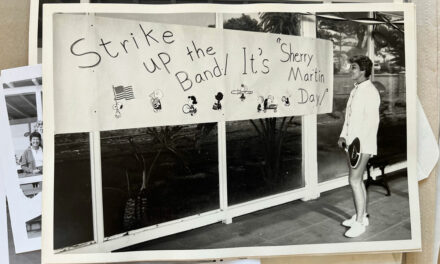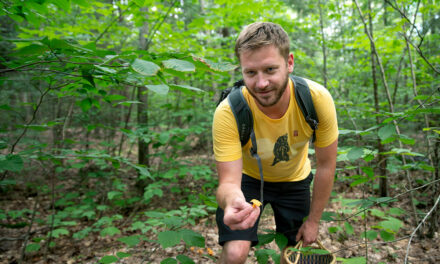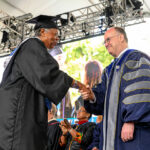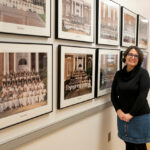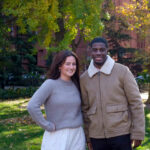
Bringing Creativity into Community
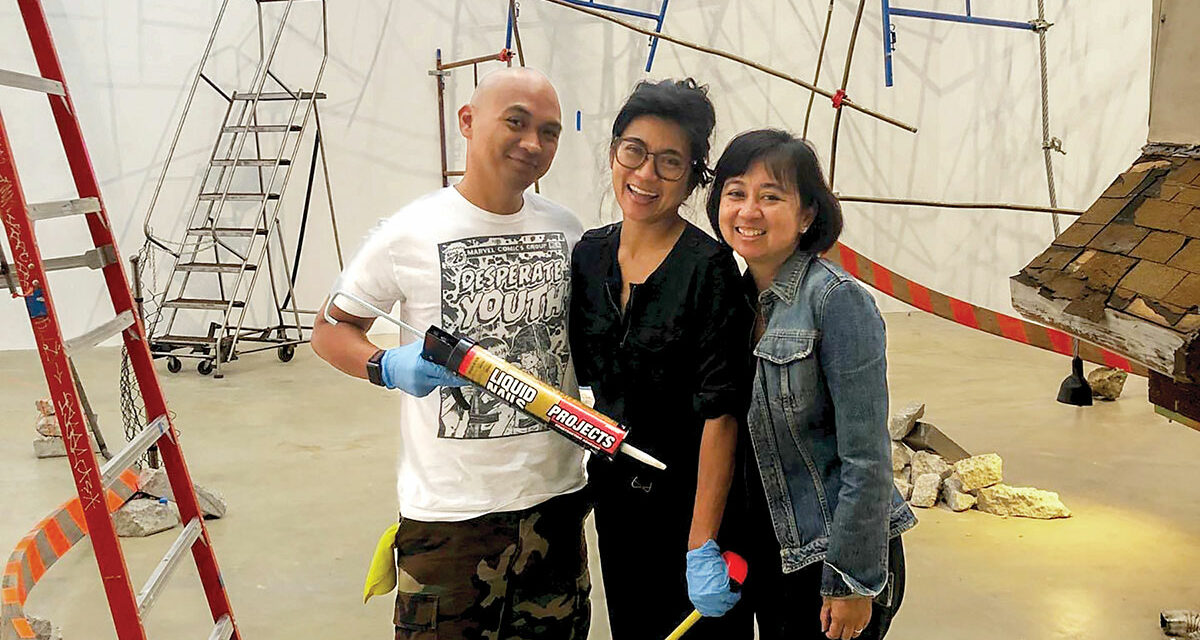
Bringing Creativity into Community
Michelle Lopez ’88 and Rudy Lopez ’96 are siblings, business partners, and professors.
BY NATHAN PUGH ’17
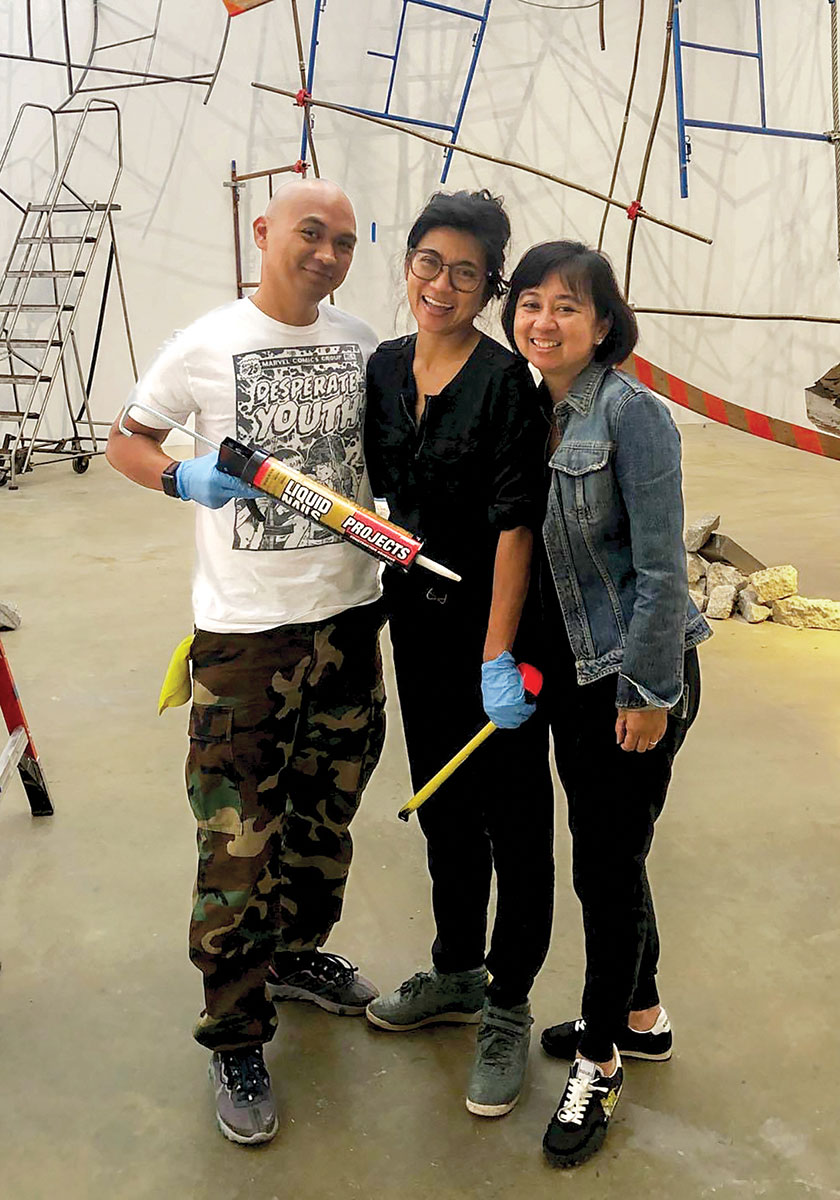
Rudy Lopez ’96, Michelle Lopez ’88, and Aileen Lopez Pugh ’85 at Michelle’s “ballasts and barricades” exhibit.
There are surreal moments of adulthood when you realize that family members exist in spaces completely outside of your own. For me, this is especially true when I’ve been able to see my aunt and uncle in their professional settings.
To this day, I still refer to the duo as “Tita Bunny” and “Tito Rudy,” respectively (the words tito/tita are Tagalog words for family, and “Bunny” is a childhood nickname for my aunt). However, when I visited my “Tita Bunny” in Philadelphia in 2021, I wasn’t just with the aunt who took me to see “Ratatouille” as a child. I was witnessing the performance art piece “Keep Their Heads Ringin’ II” by Michelle Lopez: interdisciplinary sculptor, installation artist, and Associate Professor of Fine Arts at the University of Pennsylvania. Similarly, when I attended the SSSAS Upper School for Academic Convocation this past February, I wasn’t there to hear “Tito Rudy,” the uncle who’d make me the best birthday mixes on CDs. I was there to hear the speech of Rudy Lopez: teacher, DJ, designer, and Assistant Professor at Virginia Commonwealth University.
It was thrilling to watch my aunt and uncle in their element—Michelle guiding graduate students, friends, and anyone on the street through a conceptual art piece that paraded through Philly historical sites, Rudy encouraging high school students to balance academic achievement with personal growth. I could see how the kindness they showed to me personally was also present in the roles as professors dedicated to creating and understanding art.
As a part of VCUarts’ Department of Fashion Design + Marketing, Rudy says that he sees his academic work in fashion and trend forecasting as a true collaboration with his students. “I rely on the students not just for perspectives, but just to see what they’re into. It could be everything from slang to fashion to music. That all translates into the fashion pieces I’m putting out and the research that I’m doing.”
For Michelle, working with MFA artists at the University of Pennsylvania’s Weitzman School of Design features long-form critiques by fellow artists and colleagues. She says that creating a space to sustain those interrogations is vital. “I think one of the things I’m interested in is, ‘Where is the risk in the work?’ Sometimes that risk is about you being seen as an artist, or as an individual. That honesty, being vulnerable… you have to develop a community that feels safe, so it’s a negotiation of, ‘Do people feel safe? Do people feel safe to be seen and to take those kinds of risks?’”
Although Michelle Lopez and Rudy Lopez have different careers in different industries, they’re united by more than just family. Both are passionate about bringing creativity into their local communities, and both merge creative and educational practices together to help students better understand the world around them.
My family is one of the few Asian American families with a relationship with SSSAS that stretches across generations.
My grandparents, Ruena Hernando and Rodolfo Lopez, immigrated to North America from the Philippines in the mid-1960s to work in the medical field. After the Marcos dictatorship disrupted plans to return to the Philippines, the family settled into Virginia in the 1970s, and sent all three children to SSSAS. My mother, Aileen Lopez Pugh, graduated from St. Agnes in 1985; Michelle graduated next in 1988. Rudy uniquely attended three different versions of the school: the co-ed elementary St. Agnes through second grade, the boys’ school St. Stephen’s until seventh grade, and then the merged St. Stephen’s & St. Agnes School through graduation in 1996.
Both Michelle and Rudy say they developed close-knit friend groups that they’re still in touch with today. Both also had teachers who had deep impacts on the way they understood themselves.
Michelle recalls two English teachers: Suzanne Babcock, who helped run the Madingley program which allowed her to study in Cambridge in senior year; and John Palmer, who once called her mom to encourage her to keep acting after performing a skit in class. Mr. Palmer also helped Michelle become a photo editor for the yearbook and develop a photography club, activities she credits with developing her artistic eye.
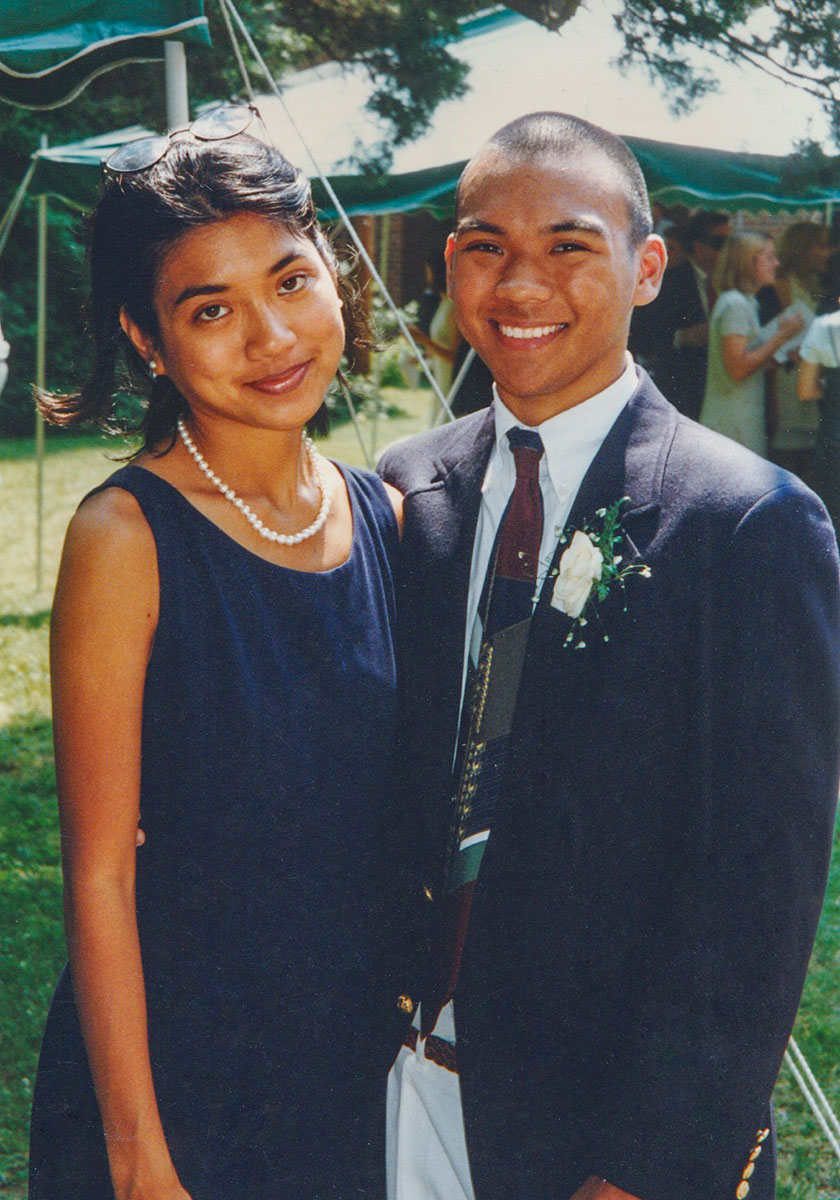
Michelle and Rudy at his SSSAS Commencement in 1996.
Rudy vividly remembers a classroom exchange with Roger Barbee, his ninth grade English teacher, and a dean of students. While discussing having to live up to expectations of older siblings, Mr. Barbee turned to him and said, “Isn’t that right, Rudy?”
“He saw me,” Rudy says. “I was kind of floored, because that wasn’t a realization for me yet.”
Other elements of identity factored into Michelle and Rudy’s time at school. Being Filipino American during that time was a challenging experience for both siblings, especially while attending schools with a majority white student body.
“I was just trying to blend in,” Michelle says. “It was more of an erasure, I didn’t try to claim any kind of ethnic identity at that time, it was just wanting to be like everyone else.”
Rudy remembers being ridiculed on the playground of Fort Ward Park for having “dirty knees,” and running to shower them in order to look like everyone else. At the same time, the dress code of St. Stephens also led him to be more curious about how to stand out with fashion; to not look like everyone else. “There was a weird duality—and that’s fashion as well—wanting to be accepted by a particular group but also standing out,” Rudy says. “When we talk about assimilation, there’s all of these weird influences and driving forces for an impressionable youth.”
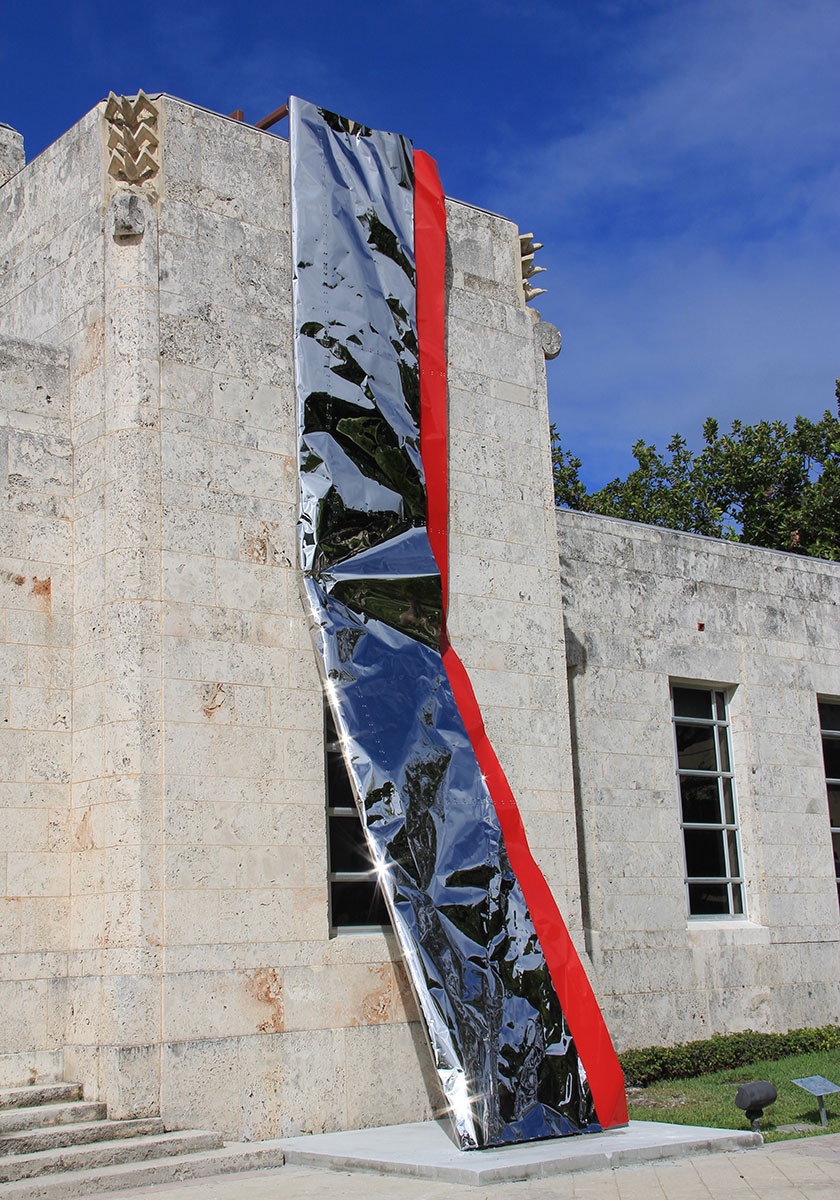
“Blue Angel” | Michele Lopez ’88
All three Lopez siblings would go onto vastly different journeys after their times at SSSAS.
Aileen went to the University of Virginia and would go on to become the CFO of Telebank in the 1990s before it was bought by E-Trade. She’d also raise me and my triplet siblings. Michelle would double major in art history and literature at Barnard. Attending galleries across New York City confirmed Michelle’s passion for visual art, and she got an MFA from the School of Visual Arts, New York.
On a trip to visit Michelle in New York City, Rudy volunteered at his sister’s fashion collective (the Organization for Returning Fashion Interest), helping prep garments, model sheets, and hang racks. The energy and excitement of the event ignited his interest in fashion, and went on to get a bachelor’s in fashion merchandising from VCU’s School of the Arts. Rudy credits the influence of both of his sisters on his career path. “Aileen was very much a business, analytical, banking career, where Michelle was the exact opposite,” he states. “So my path was both worlds.”
Michelle’s sculptures and installations have been both structurally bold and experientially evocative. In “Boy” (1999), she covered a full-scale 1970s Honda in animal leather; in “Blue Angel” (2012), a piece of crinkled aluminum around ten feet tall leans against a wall, signifying the wreckage of airplanes in the wake of 9/11. Curator Alex Klein notes in the book “Michelle Lopez: Ballasts & Barricades” that “In Lopez’s hands, signifiers of power and authority—whether a flag or a piece of heavy metal scaffolding—become physically limp, rusted, crumpled, and deflated, suggesting that they are not as immutable as we first might imagine.”
Michelle tells me that her artistic practice is often a reaction to those feelings of self-erasure she felt growing up, and continues to feel as a Filipina woman. “[My work] has also been dealing with the trauma of invisibility. How a suspended sculpture in a room can embody a kind of violence—one that’s hovering there and abject, subversively silent,” she says.
Rudy had a variety of jobs related to fashion merchandising before becoming a VCU professor. He co-owned, planned, and designed the streetwear/sneaker boutique Henry in Richmond, and also managed the store Need Supply Co. With his wife Megan Lopez, he created the teen styling company High Prospect which eventually evolved into a childrenswear company.
“In the beginning [of my career], I was trying to make art that was in dialogue with an international scene. Now, I’m just trying to claim more space of who I am (being brown), in ways that feel slightly uncomfortable, because it is uncomfortable! Uncomfortable for me, because that’s not how I was conditioned, but I think with this new kind of climate, it does feel like an imperative.”
~MICHELLE
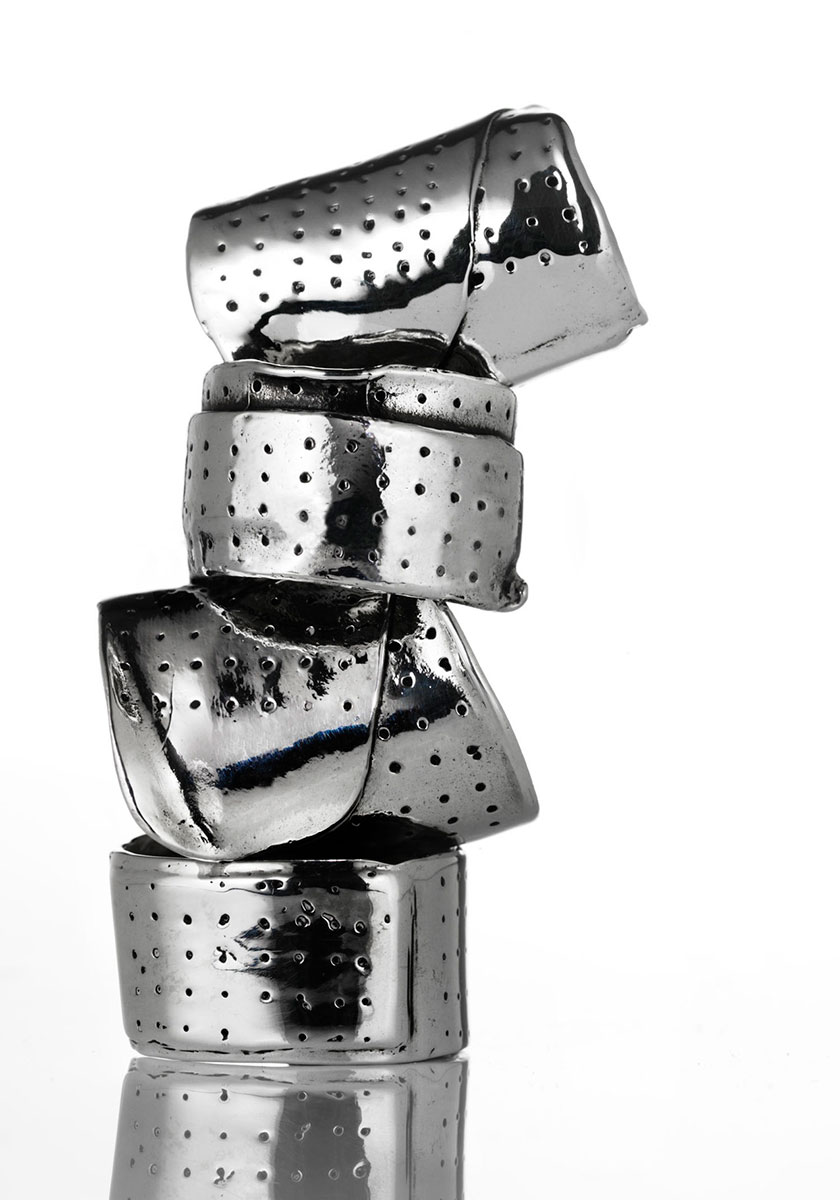
Bandaid ring from Michelle and Rudy’s company, esses.
A project that Rudy is very proud of, one continuing to this day, is esses. It’s an independent ring company which he co-founded with Michelle in 2011 (he serves as the director, she serves as the designer). Named after a cursive sign Michelle found on a cross-country road trip, esses is best known for their band-aid rings. The rings made out of sterling silver or gold fashioned to look like band-aids wrapped around your fingers, yet still function as wearable art. Rudy describes wearing the ring as a potential “healing process,” to externally embody pain that can often be internal.
Michelle agrees. “People have this moment where the ring touches them in a way,” she explains. “They’re going through some kind of pain, symbolic pain, and they buy the rings as if it’s this protector if they’re going through loss, or grief. If they’re going through a divorce, they remove their wedding ring and get a band-aid ring.”
Both Michelle and Rudy have continued to grow their families over time. Michelle has a son who’s currently in the tenth grade; Rudy has two sons, one in the third grade, one born this past December.
The past few years have been prolific for both siblings. Michelle was awarded the prestigious Guggenheim Fellowship in May of 2019. In the same year, she opened the exhibit “Ballasts & Barricades” at Philadelphia’s Institute of Contemporary Fine Art (ICA), one of her largest and most ambitious works to date. A site-specific installation taking full advantage of the ICA’s 30-foot high ceilings, “Ballasts & Barricades” uses the fragment of a building to act as a counterweight to support a collapsing scaffolding system. As Michelle has continued her work as a professor, she’s been intrigued by the idea of creating experiences, not just objects. “I think about the way that Mr. Palmer saw that drama kid in me,” she says. “I’m always trying to figure out how I’m performing, how I can perform things through space. [“Ballasts & Barricades”] was about performing these gestures in space.”
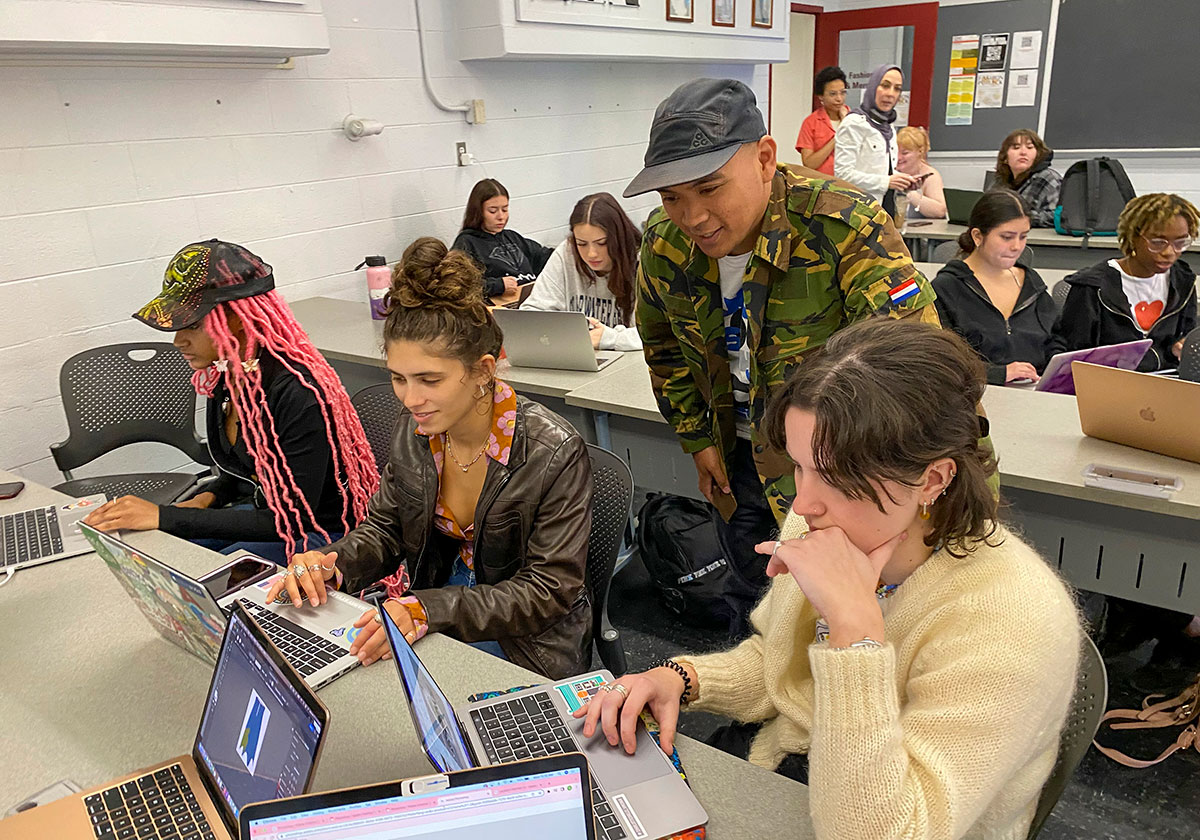
“One of my goals within our department is building a stronger community—through fashion, through events, through art. My research and the work and the events I’m doing all directly tie into the students, because when there’s a stronger community, there’s stronger work done and better work created. ”
~RUDY
Since 2017, Rudy has been teaching the class Fashion Forecasting at VCU.
Despite the title of the class, Rudy makes sure students develop a historical understanding of cultural trends and societal changes. “Forecasting is identifying what’s going out there in the real world, identifying the zeitgeist, identifying what’s driving consumer behavior,” he explains. “It’s not necessarily just fashion. What are the cultural changes? How is society shifting?” For students, the class may be radically different from what they’re used to academically, since the class depends on developing and arguing for their perspectives. “It’s unlike any other class my students take. It’s much more conceptual thinking, a lot of it opinion-based,” he says.
For Michelle and Rudy, the past few years have been both difficult and rewarding as they notice the cultural shifts impacting their industries as well as communities. Michelle points to 2020, a pandemic year when both protests occurred over the murder of George Floyd and also anti-Asian hate crimes were on the rise, a turning point in her understanding of identity. “I’m sure so many minorities felt this, but after George Floyd, I felt an extreme amount of rage from all of my collective experiences of being a minority,” she says. “That doesn’t always come in the work, but I feel like now it’s a priority for me, being more honest about who I am.”
You can see this honesty in works like the performance art piece I attended in 2021, “Keep Their Heads Ringin’ II.” Michelle led a free walking tour of Philadelphia’s Independence Park, featuring hundreds of people playing her audio installation “Keep Their Heads Ringin’” on speakers and phones. The audio featured ringings of a clock tower bell as well as the words “ching-chong” and “ding-dong” repeated ad nauseam near the site of the historic Liberty Bell. The effect resembled a protest or a funeral march, and the public display of discomfort was purposeful. “In the beginning [of my career], I was trying to make art that was in dialogue with an international scene,” she says. “Now, I’m just trying to claim more space of who I am (being brown), in ways that feel slightly uncomfortable, because it is uncomfortable! Uncomfortable for me, because that’s not how I was conditioned, but I think with this new kind of climate, it does feel like an imperative.”
Rudy says that the way he’s approached his Fashion Forecasting class has shifted over the six years he’s taught it. He’s also felt like the way he brings his Filipino identity into his career has changed. “Being younger I wanted to create something that other people would like, it was never about self identity or telling people who I am, but I guess in an indirect way it is,” he explains. “If I’m thinking about recent projects, I think working at VCU and becoming a professor, working more in research, there is a lot more thought in things conceptually.”
Michelle and Rudy both agreed that education can be a helpful tool in discussing these societal changes, and that it’s important to just be honest about experiences with racism or oppression. That honesty even includes experiences from St. Stephen’s and St. Agnes. When Rudy talked to the Asian affinity group on the Upper School campus after Academic Convocation, it reaffirmed for him that many of the same struggles he went through growing up as an Asian American are still being experienced by Asian American students today. Rudy and Michelle feel it is important to speak up about the work the school is doing, and the work that still needs to be done.
SSSAS DEIB PROGRAMS
During the last two decades, SSSAS has continued to mold and advance our programs to create a diverse, equitable, and inclusive environment, in which students can feel a sense of belonging—and we still have work to do.
While our community is intentionally diverse and that diversity continues to grow, the increase of people from different backgrounds, cultures, and perspectives that makes our school rich and vibrant also means that we, as an institution, have to be deliberate about how we provide support to and understanding of that diversity. With our mission and Episcopal identity at the core, we are constantly reevaluating what it means to be a place where all of our members can succeed in a complex and changing world and what we need to do to ensure that everyone feels like a child of God in a caring community.
Programs like affinity groups on all three campuses provide support for those that are from underrepresented and historically marginalized communities. Our respectful discourse program allows students to develop dialogue skills that transfer into everyday life opportunities to understand the many perspectives that exist at our school and in the world around them. Students participate in scheduled time to think, wonder, understand, and practice what it means to see the world around them with empathy and understanding.
The school recognizes that having adults in our community who model equity and inclusion is vital. Every adult member of the Saints community participates in cultural competency workshops to ensure that they have a foundation of understanding of what it means to work in a diverse community. SSSAS also provides professional development opportunities throughout the year, so their competency is fueled by the confidence to serve each student in a way that makes them feel seen, heard, valued, and validated.
Creating institutional practices, community expectations, and having clear and transparent communication is paramount to ensuring our students and families not only feel at home at SSSAS, but also that they are an integral part of the fabric of our community.
The urge for full honesty when it comes to creating art and existing in a community seems like a recent development for both Michelle and Rudy.
The ability to say how they really felt was a privilege that wasn’t afforded to them due to factors completely outside of their control. Yet as professors working in the education field now, they both have the ability to use their platforms to inspire more vulnerable dialogues and more risk-taking creative endeavors.
For Rudy, this means using his position within VCU to connect with the greater Richmond area, and create a more connected academic space. “One of my goals within our department is just building a stronger community,” he says. “My research, work, and events that I’m doing all directly tie into these students, because when there’s a stronger community, there’s stronger work done.”
Rudy is also finding new ways to connect with SSSAS. In addition to speaking at Academic Convocation, last year he presented the Diversity, Equity, Inclusion, and Belonging Award: a new prize given to the Upper School students who most embody what it means to support and actively work towards social justice. In collaboration with KiKi Davis and SSSAS, the award was created by the Class of 1996. Rudy says it’s important to bridge the generation that experienced the merger of St. Stephens and St. Agnes and the generation going to SSSAS now.
Michelle wants to encourage everyone, including students currently attending SSSAS, to boldly chart new paths for themselves. “If you feel like there’s an absence at the school, build something that fills that gap,” she says. “Build it for yourself, but also for the community, because people will most likely benefit.”
Just as Mr. Palmer recognized Michelle’s creative potential of Michelle and Mr. Barbie once “saw” the experiences Rudy was going through, both Michelle and Rudy are paying forward that same generosity in education to the next generation of students. I’ll forever call them “Tita Bunny” and “Tito Rudy.” Seeing their work as educators, I’m grateful to know that you don’t have to be family members with Michelle Lopez and Rudy Lopez to feel the impact of their creativity and education in their communities.

